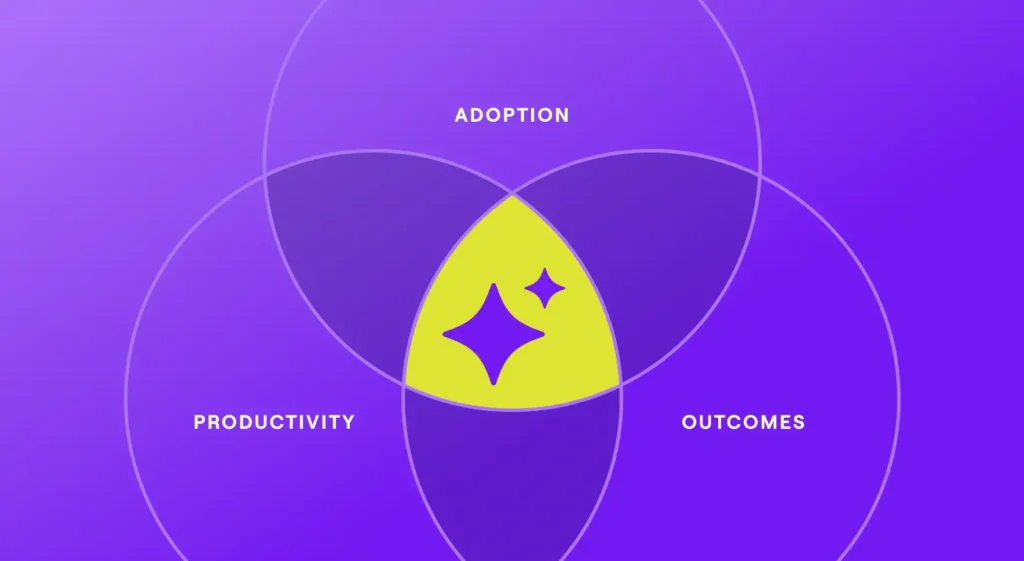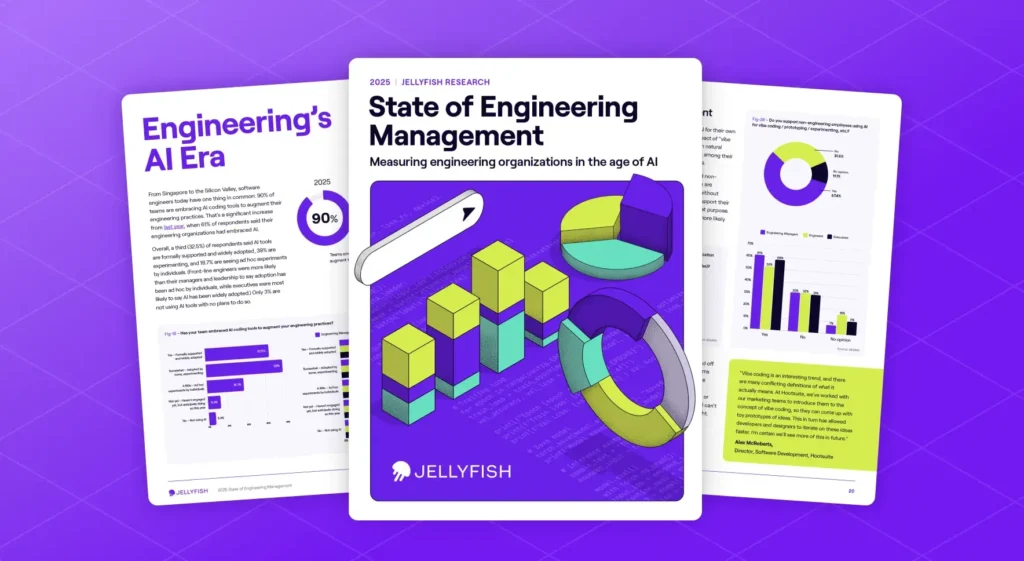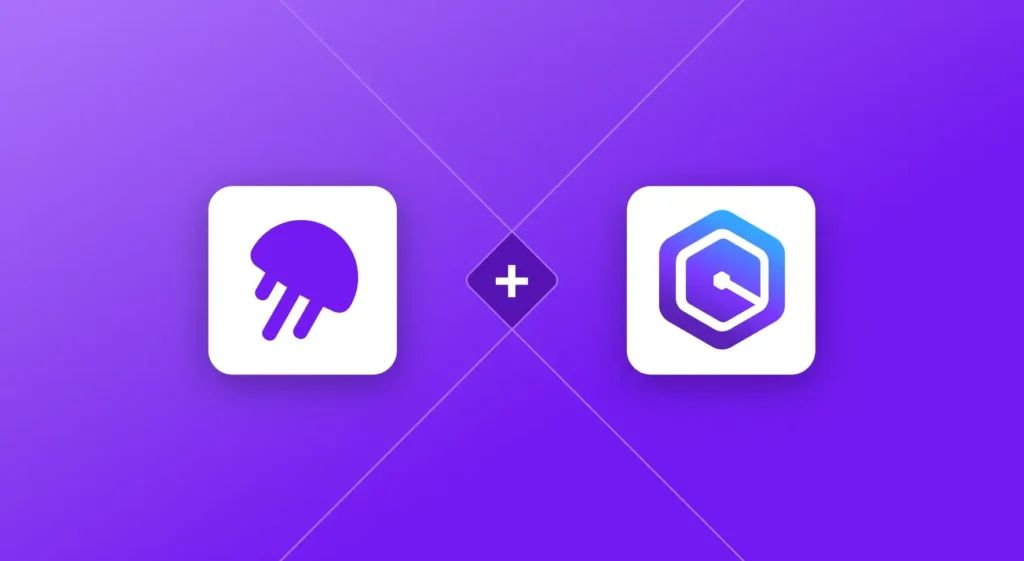In this article
Software development has been a black box for a long time: Developers put in long hours of work and out pops new features, apps, and products. But how efficiently are those teams working? Are they collaborating well? Are they working on initiatives that matter most for the business?
Software engineering intelligence platforms (SEIPs) aim to solve engineering’s black box problem by illuminating the entire software delivery lifecycle so engineering leaders can make more informed, data-driven decisions.
Read on to learn more about SEIPs and why they’re important for modern engineering teams.
What Is a Software Engineering Intelligence Platform?
What Is a Software Engineering Intelligence Platform?
A software engineering intelligence platform is a tool that provides greater visibility across the software development lifecycle (SDLC) so engineering leaders can use a data-backed approach to improving the software development process, managing teams, and tracking alignment with business goals. A SEIP might track data around resource allocation, team health, engineering metrics, and more.
Traditionally, engineering leaders have relied on manual systems and tools for engineering management, such as customized spreadsheets or status meetings. While this might work occasionally, these methods often force engineering leaders to make important decisions based on a limited view of engineering work combined with gut instinct.
SEIPs allow engineering leaders to take a data-driven approach to engineering management instead of an intuition-based approach. This makes it easier to make informed decisions, drive collaboration, and align engineering work with business goals.
Note: Traditionally, a SEIP has referred to a platform that focuses on the software development process, whereas an engineering management platform (EMP) encompasses software development, team health, and alignment with business objectives. Today, however, most companies use SEIP and EMP interchangeably.
How Does a Software Engineering Intelligence Platform Work?
How Does a Software Engineering Intelligence Platform Work?
Software engineering intelligence platforms connect with various development tools, collect and analyze data from those tools, and then present insights from that data in dashboards and reports.
Here’s what you can expect with integrating a SEIP into your workflows:
- Data collection: Most SEIPs integrate with common and popular developer tools that companies frequently use throughout the SDLC. For example, a SEIP might integrate with tools like Git repositories (GitHub, GitLab), CI/CD pipelines (Jenkins, CircleCI), project management software (Jira, Trello, Asana), and communication platforms (Slack, Microsoft Teams).
- Data processing and analysis: The SEIP will collect data from these tools, then analyze it to calculate key metrics (such as cycle time, deployment frequency, lead time for changes, etc.) and identify trends, bottlenecks, and areas for improvement.
- Presentation of insights: Data is presented in easy-to-understand, customizable dashboards and reports. Engineering leaders can use these insights to track progress toward goals, make data-driven decisions around workflow efficiencies, and communicate the impact of engineering work to stakeholders.
In short, a SEIP provides a comprehensive, centralized, and real-time view of engineering work so organizations can optimize development and drive continuous improvement.
Benefits of Using a Software Engineering Intelligence Platform
Benefits of Using a Software Engineering Intelligence Platform
A software engineering intelligence platform empowers engineering leaders to manage engineering teams based on data, rather than instincts alone. Day to day, engineering leaders can leverage a SEIP to drive a range of powerful benefits that improve the efficiency, effectiveness, and predictability of software development teams.
The key benefits of using a SEIP include the following:
- More efficient software development processes: Most SEIPs provide granular and big-picture insights into engineering work that make it easier to identify ways to streamline the development process. For example, a SEIP might reveal areas ripe for automation of repetitive tasks, bottlenecks in CI/CD pipelines, and other process improvements that promote faster development cycles and reduced costs.
- Enhanced code quality and reliability: Engineering metrics like code churn, complexity, and test coverage give engineering leaders the insights they need to proactively identify and resolve issues, reduce downtime and defects, and improve overall user satisfaction.
- Improved project predictability: Engineering leaders can improve project predictability with a SEIP by following a structured approach to managing complex projects, practicing better planning and resource allocation, and quickly pivoting when needs shift. More predictable projects also make it easier for teams to scale engineering efforts.
- Informed decision-making and risk management: A SEIP provides engineering leaders with data needed to make strategic management decisions, such as how to allocate resources, prioritize projects, reduce the risk of costly setbacks or potential roadblocks, and more. Leaders can also use a SEIP to look at the big picture, such as the ROI of different initiatives and whether work aligns with business priorities.
- Continuous improvement: SEIPs provide continual, real-time insights on engineering work, which means engineering leaders can use them to assess the effectiveness of new processes, find areas for enhancement, and iterate on improvements in quality and efficiency.
- Improved team health: Engineering leaders can leverage a SEIP for a more complete picture of team health, such as how work is distributed or how well teams collaborate. Team health insights can help leaders prevent burnout and drive team morale.
Key Features to Look for in Software Engineering Intelligence Platforms
Key Features to Look for in Software Engineering Intelligence Platforms
When considering different SEIPs, it’s important to find one that works with your tech stack. It should also provide insights that support your engineering management goals, whether that’s improving team health or increasing cycle times. Consider the following capabilities when evaluating potential software engineering intelligence platforms.
Data Integration
A SEIP should seamlessly integrate with the critical tools your engineering teams already use. This includes Git repositories, CI/CD pipelines, project management platforms, and communication tools. By aggregating data across the entire development lifecycle, SEIPs ensure that engineering leaders have a comprehensive view of team performance and operational efficiency.
Data Management
Data collection is only useful if it is properly organized and processed. A SEIP should aggregate and clean data from various sources, ensuring accuracy and consistency. This allows engineering teams to work with a reliable source of truth rather than fragmented or conflicting information.
Analytics and Reporting
A key function of SEIPs is their ability to analyze engineering data and generate meaningful insights. These platforms provide comprehensive analytics on code quality, team performance, and process efficiency. By identifying bottlenecks and areas for improvement, SEIPs help teams optimize their workflows and deliver higher-quality software.
Insights and Recommendations
To get the most out of a SEIP, look for one that does more than present data; look for a SEIP that offers actionable insights and recommendations. Whether it’s suggesting ways to reduce inefficiencies, identifying risks before they escalate, or highlighting best practices, these platforms enable engineering leaders to spend less time interpreting data and more time acting on it.
Predictive Modeling (if Needed)
Advanced SEIPs leverage predictive analytics to forecast potential challenges. By analyzing historical trends and development patterns, these platforms can predict project delays, detect potential bugs, and suggest ways to optimize resource allocation. This helps teams stay ahead of risks and plan more effectively.
Customization and Extensibility
Every engineering organization has unique needs, and a SEIP should be flexible enough to accommodate them. The best platforms allow teams to customize dashboards, define relevant metrics, and extend functionality through integrations or API support. This ensures organizations can tailor the platform to their specific workflows and objectives.
10 Best Software Engineering Intelligence Platforms on the Market Right Now
10 Best Software Engineering Intelligence Platforms on the Market Right Now
1. Jellyfish
Jellyfish is a software engineering intelligence platform that provides visibility into engineering work and helps organizations align their development efforts with business priorities. Jellyfish seamlessly integrates with tools teams already use, like Git repositories, project management tools, and communication platforms so engineering leaders can make data-driven decisions around team health and performance, investment allocations, and project progress.
Key Features
- OKR Integration: Connects engineering work directly to business objectives and key results (OKRs), providing a clear line of sight between technical efforts and business outcomes.
- DORA Metrics & Engineering Dashboards: Offers customizable dashboards with a range of engineering metrics, including cycle time, deployment frequency, lead time for changes, and more, providing real-time visibility into team performance.
- Business-Level Reporting: Bridges the gap between engineering and the business by translating technical metrics into business-relevant insights, showing the impact of engineering work on key business drivers.
- Actionable Insights: Provides data-driven recommendations for improving engineering processes, optimizing resource allocation, and addressing potential bottlenecks.
- Integrations with Development Tools: Seamlessly integrates with popular development tools like Jira, GitHub, GitLab, and others, automatically collecting data and eliminating manual reporting.
- Team Collaboration Features: Facilitates communication and collaboration between engineering teams and stakeholders, fostering a shared understanding of progress and goals.
- Customizable Reporting: Allows users to tailor reports and dashboards to their specific needs, focusing on the metrics that matter most to your engineering organization.
Top Advantages
- Alignment of Engineering with Business Goals: Jellyfish’s OKR integration and business-level reporting are its core strengths, ensuring that engineering efforts are focused on the most impactful software projects and directly contribute to business success. This is a key differentiator compared to platforms focusing primarily on developer-centric metrics.
- Improved Visibility and Transparency: Jellyfish provides a unified view of engineering performance, making it easy for engineering leaders and stakeholders to understand progress, identify potential issues, and make data-driven decisions.
- Data-Driven Decision Making: By providing actionable insights and recommendations, Jellyfish empowers engineering teams to optimize processes, improve engineering efficiency, and deliver better software faster.
- Enhanced Collaboration: Jellyfish facilitates communication and collaboration between engineering teams and stakeholders, fostering a shared understanding of goals and progress. Read how nCino built organization-wide trust with Jellyfish.
- Increased Efficiency: By identifying bottlenecks and streamlining workflows, Jellyfish helps engineering teams work more efficiently and deliver more value with the same resources.
- Focus on Business Outcomes: Unlike platforms that only track technical metrics, Jellyfish connects engineering performance to business outcomes, allowing organizations to measure the impact of their engineering investments. This makes it particularly valuable for organizations looking to tie engineering efforts to business results.
2. LinearB
LinearB is a software engineering intelligence platform that emphasizes developer experience, developer productivity, predictable software delivery, and profitable engineering. It tracks key quantitative and qualitative data, offers automation capabilities, and features tools for leaders such as project forecasting and cost capitalization.
Key Features
- Reporting, such as engineering metrics, developer surveys, and custom insights
- Automation capabilities, such as programmable workflows, bot assistants, and more
- Engineering leader-specific tools, such as project forecasting, resource allocation, and developer coaching
Pros
- Focus on developer workflow and efficiency
- Excellent customer support and service
- Good integrations with Git platforms
Cons
- Less focused on business-level metrics and reporting
- The depth of customization might be limited
- Some want broader integrations
Pricing
LinearB offers three tiers of pricing:
- Free: $0/month to track DORA metrics
- Business: $49/month/contributor
- Enterprise: Inquire for custom pricing
3. Code Climate Velocity
Code Climate Velocity is an engineering intelligence platform designed to provide engineering leadership with a personalized approach to data-driven decision-making. The company follows a three-step process with customers that includes holding a diagnostic workshop, creating customized dashboards and reports, and sharing a tailored action plan.
Key Features
- DORA and other key engineering metrics help leaders assess team speed, identify areas for improvement, and deliver more value
- Team360 provides a holistic view of team health to improve productivity and help developers excel
- Data hygiene standards combined with machine learning and analysis ensure insights are accurate and trustworthy
Pros
- Helps maintain high quality
- Supports continuous improvement
- Great for team health at large organizations
Cons
- Pricing can be a factor
- Users wish there was a better way for metrics to account for PTO, training, holidays, etc.
- Some feel data isn’t actionable
Pricing
Code Climate Velocity offers a 14-day free trial for its team tier, as well as affordable options for small teams.
- Open Source: Free
- Startup: $0, up to four seats
- Team: $16.67/month/seat if billed annually
4. Waydev
Waydev is an engineering intelligence platform that uses DORA metrics, the SPACE framework, developer experience insights, and AI capabilities to help engineering leaders accelerate development velocity and align with business priorities.
Key Features
- Diverse delivery metrics, including DORA, SPACE, velocity, and merge quality reports, as well as team health insights
- Planning tools such as “Bird’s-Eye View,” resource allocation, and project costs
- Automation features like WAY AI Agents and automated notifications
Pros
- Automated emails are helpful for key updates
- Custom dashboards and reports are useful
- Good variety of integration options
Cons
- Some users would like the ability to further customize dashboards
- More documentation and tutorials on getting started would be useful
- Occasionally it can be slow
Pricing
Waydev’s plans are billed annually. Teams can choose between:
- Pro: $24.91/month/contributor. Includes up to 50 repositories
- Premium: $45.75/month/contributor. Includes up to 300 repositories
- Enterprise: Inquire for pricing. Unlimited repositories
5. DX
DX considers itself a developer intelligence platform. With DX, users can leverage metrics, benchmarks, and insights to drive more impact per developer.
Key Features
- Qualitative and quantitative data in a single platform for a complete view of developer productivity
- Benchmarking against specific peer companies and industry segments to evaluate company performance
- AI capabilities help users create reports, understand data, and take action on insights
Pros
- Great customer support
- Easy to run surveys with high participation rates
- LLM-supported data querying is helpful
Cons
- Lack of Azure DevOps support
- Data studio features can be unpredictable
- Users are looking for more features and functionality
Pricing
Organizations can choose between different DV products and offerings. Pricing is not available on the DX website.
6. Swarmia
Swarmia is an engineering intelligence platform focusing on business outcomes, developer productivity, and developer experience. Swarmia helps business leaders better understand where engineering is spending its time.
Key Features
- Investment insights and real-time visibility into project delivery fuel business outcomes
- Productivity metrics combined with automation help boost developer productivity
- Engineering surveys provide insight into the developer experience
Pros
- Excellent depth of project management and CI insights
- Notifications from the Slack bot are helpful
- Helpful for team members in different roles
Cons
- A better breakdown between types of work could clarify how effort is spent
- Some users would like more control over how they filter or view different metrics
- Can be slow to load
Pricing
Swarmia offers a free plan for companies with up to nine developers. Teams that invest in the “Standard” plan gain access to all three modules (Business outcomes, developer productivity, developer experience) for $39/month/developer. Alternatively, users can choose a single module for $20/month/developer.
7. Athenian
Athenian is an engineering insights platform that helps software engineering teams autonomously improve their processes and performance. It provides a comprehensive view of engineering-team work (rather than the work of individuals), from code commits to releases, and offers tools for tracking progress, identifying bottlenecks, and optimizing workflows.
Key Features
- The Athenian Insights Graph automatically aggregates insights from Jira, Github, and CI systems for rich insights into bottlenecks
- Engineering metrics keep the focus on teams rather than individual developer performance
- Engineering success managers drive continuous improvement
Pros
Cons
- Lacks qualitative insights to balance out quantitative metrics
- The user interface can be slow to load
- Some users report slow customer support
Pricing
Teams of up to 30 engineers can use Athenian’s standard plan, which is $39 per developer per month. The business plan, which is $49 per developer per month, accommodates up to 200 engineers. Larger teams should inquire about custom pricing.
8. Allstacks
AllStacks calls itself a value stream intelligence platform. Its goal is to empower engineering teams to view project health, align with business objectives, commit to goals, and more. AllStacks analyzes data across the software development lifecycle using AI and machine learning to identify project risks, predict potential delays, and improve delivery predictability.
Key Features
- AI-powered risk prediction identifies potential risks and delays based on historical data and project patterns
- Predictive forecasting identifies project completion dates and provides insights into potential roadblocks
- Data-driven insights help leaders make decisions around team performance, project health, and engineering efficiency
Pros
- Helps identify areas for team improvement
- Makes it easy to track teamwork against company objectives
- Excellent visualization capabilities
Cons
- Could use more advanced filter options
- Some users find that tools and features are not as advanced as other platforms
- Data could be synchronized more frequently
Pricing
Pricing for Allstacks is based on the number of contributors. Teams can contact Allstacks for a free trial or tack on a software capitalization tool for an additional $200/contributor/year.
- Premium: $400/contributor/year, for up to 500 users
- Enterprise: $650/contributor/year, for unlimited users
9. Faros AI
Faros AI is a software intelligence platform that provides visibility throughout the software development process. Faros AI ingests data from standard and custom data sources and analyzes it with AI to provide real-time intelligence and guidance.
Key Features
- Delivery and productivity features include DORA metrics, developer experience surveys, initiative tracking, and more
- Budget tools such as software capitalization help teams align with business outcomes
- AI helps automate repetitive tasks, build reports and dashboards, and understand engineering data
Pros
- Fosters better team collaboration and alignment on goals
- Good mix of out-of-the-box capabilities and flexibility
- Responsive customer support teams
Cons
- It can be time-consuming to keep data from non-standard sources synced correctly
- There’s an initial learning curve
- Some users report minor configuration challenges
Pricing
Faros.ai offers three tiers, with pricing available upon request.
10. Haystack
Haystack is an engineering analytics platform that helps software teams improve their development process. It focuses on providing actionable insights to help you optimize your workflow and deliver software faster.
Key Features
- Automated risk detection identifies delivery blockers and risks and sends them to your inbox or team channel
- Weekly insight reports show progress, investments, and opportunities
- Delivery boards provide a single spot for teams to view work, including data on sprints, pull requests, release notes, and more
Pros
- Provides high-fidelity insights and fine-grain awareness
- Risk alerts provide actionable insights
- Good team performance metrics
Cons
- Some users aren’t sure how to make data actionable
- Historically, there have been some performance issues
- Some people note they’re waiting for more features
Pricing
Haystack offers two pricing tiers: The Growth tier at $20/month/member for teams of 100 or less, or the Enterprise tier, with custom pricing. Users can try the Growth tier with a 14-day free trial.
Jellyfish – #1 Software Engineering Intelligence Platform
Jellyfish – #1 Software Engineering Intelligence Platform
With a software engineering intelligence platform, engineering leaders no longer need to update complicated spreadsheets or make wild guesstimates. Instead, SEIPs like Jellyfish empower engineering leaders to practice data-driven engineering management so they can drive team productivity, keep tabs on team health, and align work with business goals.
Ready to give data-driven leadership a try at your organization? Try out a Jellyfish demo.
About the author

Lauren is Senior Product Marketing Director at Jellyfish where she works closely with the product team to bring software engineering intelligence solutions to market. Prior to Jellyfish, Lauren served as Director of Product Marketing at Pluralsight.





